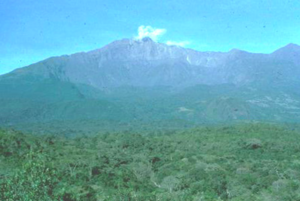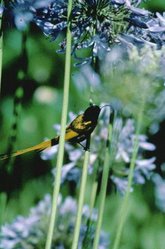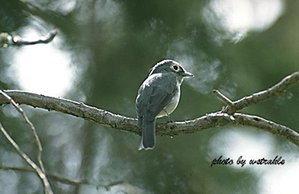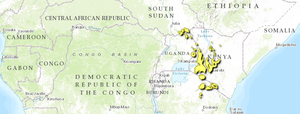East African montane forests

Situated on disjunctive and isolated mountain ranges, the East African montane forests ecoregion is found in southern Sudan, Kenya, Uganda, and northern Tanzania. The ecoregion consists of more than 25 montane forest patches (or elevational islands) of various sizes. Two of the central patches are large (23,700 km2 and 14,300 km2), five are medium sized, and the remaining 18 outliers are relatively small (smallest is 113 km2) and scattered on surrounding mountains. The ecoregion is rich in endemic species, although the numbers of endemics are lower here than in other eastern African mountain ecoregions. The primary threats to the ecoregion come from forest clearance due to an expanding population needing new farmland, and from forest degradation due to a number of exploitative activities, including timber logging.
Location and General Description
The East African montane forests ecoregion is found as moderate- to high-altitude patches along a chain of isolated mountain ranges along the Rift Valley, from southern Sudan, though Uganda and Kenya, to northern Tanzania. The mountains stretch from their northern extent at Mount Kinyeti in the Imatong Mountains in southern Sudan, through Mount Moroto and Mount Elgon (34.30° E, 01.00° N) in Uganda, and the Aberdare Range to Mt. Kenya (38.00° E, 00.00° N/S) in Kenya. Further south, the ecoregion includes the forests of the Nguruman Scarp in southern Kenya and Mt. Kilimanjaro, Mt. Meru, and Ngorongoro in northern Tanzania (to 04.00° S). There are many small outliers in eastern Uganda, along the eastern Rift Valley of Kenya (Mt. Kulal, Mt. Nyiru, and Bukkol), and in northern Tanzania on isolated higher mountains to the south of the main northern volcanoes, as far south as the Marang forests.
The ecoregion is found at altitudes between 1000 to 3500 metres (m). Due to the higher altitude the climate is relatively temperate and seasonal, with temperatures falling below 10° Celsius (°C) in the cold season (coldest in July and August) and rising to above 30 °C in the warm season. At higher altitudes, frosts are possible. Rainfall varies between 1200 and 2000 millimetres (mm) per annum, with a distinct wet (October-December and March to June) and dry season (January and February and July to October). The climate of these mountains is considerably wetter than the surrounding lowlands, and seasons are less clearly defined. Climatic conditions and temperatures vary by region and elevation throughout the ecoregion, and local conditions can modify this general pattern.
Geologically, the rifting of the African Plate system has heavily influenced the area. The rifting was caused by the rotation of Africa that has narrowed the Mediterranean Sea and forced up mountains in North Africa and Southern Europe. The pressure of this movement formed large cracks in East Africa, as seen in the Rift Valley system. Associated with this rifting was the development of several active volcanoes in the area, most famously Mount Kilimanjaro and Mount Meru in Tanzania, and Mt. Kenya in Kenya. There are also a number of other mountainous areas within the ecoregion, such as the Ngong Hills, Aberdare Mountains, the Mau range, Kakamega forest and others. The soils in this ecoregion are complex due to differences in soil, climate, and altitude. Most of the area has a volcanic base rock, which means that soils are typically fertile and highly suitable for agriculture.
The ecoregion is dominated by sub-montane and montane forests, although there are some areas of bamboo, grassland, and rocky habitats. At higher altitudes the ecoregion grades into the Afromontane heathland/moorland and Afroalpine vegetation in the East African Montane Moorland ecoregion. The northern forests of this ecoregion form the headwaters of the White Nile, and much of the western portion of the ecoregion drains to Lake Victoria – which also flows to the Nile.
Human population is high throughout the ecoregion, and is rapidly increasing in Kenya. Population density is 200-300 persons per square kilometer in many areas. This density typically remains high right up to protected area boundaries, and in some cases, human encroachment extends within the borders of the reserves themselves.
In terms of phytogeographical classification, the area is regarded as a part of the Afromontane Archipelago-like regional center of endemism. The vegetation formerly consisted of a mixture of various kinds of forest, with bamboo and heathland/grassland at higher altitudes. The forest is most highly developed on those parts of the mountains receiving the most rainfall (east/south), but much of the original habitats have been lost where they are not protected - especially at lower altitudes where they are most accessible.
Biodiversity Features
This ecoregion contains moderate levels of species richness and relatively low rates of endemism when compared to the other tropical forest ecoregions around the equatorial belt of Africa. However, it does contain endemic species and the mix of plants and animals is of interest for interpreting the biogeographical history of the area. There are a number of narrow centers of plant endemism in the ecoregion, although most of the endemism is concentrated in the heathland ecoregion found on the highest mountains of the area above the East African Montane forests, which is of lower relative importance for the conservation of endemic plants.

The avifauna in these mountains are quite diverse, and express moderate levels of endemism. The WWF lists eight endemic and restricted range bird species. Because of the patchy geographic distribution of this biogeographic island "archipelago", the endemic birds present also exhibit patchy distributions. Some of the endemic species, such as the Aberdare cisticola (Cisticola aberdare), Abbotts starling (Cinnyricinclus femoralis, VU) and Kenrick’s starling (Poeoptera kenricki), occur on only two or three mountain ranges within the ecoregion. Others, for example Hunter’s cisticola (Cisticola hunteri), Jackson’s francolin (Francolinus jacksoni), and Sharpe’s longclaw (Macronyx sharpei), occur in most (but not all) of the major mountains in this ecoregion. Some of these species are typical of the montane forest, while others are found only in the montane grasslands within the ecoregion.
Mammal endemism is more pronounced, and includes a number of strictly endemic mammal species. There are no endemic large mammals, however, presumably because the areas of forest are insufficient to support unique large forest mammal species. In the small mammals there are eight species of strictly endemic species, mainly in the shrews (Crocidura gracilipes (CR), Crocidura raineyi (CR), Crocidura ultima (CR), Surdisorex norae (VU) and Surdisorex polulus, VU), and in rodents: Grammomys gigas, (EN), Tachyoryctes annectens, (EN), Tachyoryctes audax (VU). Near-endemic mammals include Jackson’s mongoose (Bdeogale jacksoni, VU), Abbot’s duiker (Cephalophus spadix, VU), Sun squirrel (Heliosciurus undulatus), and the Eastern tree hyrax (Dendrohyrax validus, VU). The foregoing abbreviations are as follows: CR denotes Critically Endangered; EN denotes Endangered; VU denotes Vulnerable species conservation status.
The herpetofauna is also of interest and contains a number of strictly endemic species, particularly in the Chameleons. There are nine strictly endemic reptiles, of which six are different Chameleon species, often known from a single mountain in the ecoregion. The reptiles include the montane viper (Vipera hindii). The amphibian fauna, although of importance, is much poorer than the adjacent Eastern Arc mountains ecoregion. In comparison there are two strictly endemic species of amphibian in the East African Mountains, and around 30 in the Eastern Arc. The Marsabit Clawed Frog (Xenopus borealis) is a near endemic anuran, which is also found in the upper elevations of the adjacent East African montane moorlands ecoregion. Other anurans found in the East African montane forests include the Molo frog (Amietia wittei)
The rates of endemism in the East African montane forests ecoregion are lower than in some of the other eastern African forested blocks (e.g., the Albertine Rift (Albertine Rift montane forests), Eastern Arc Mountain forests, and Northern Zanzibar-Inhambane coastal forest mosaic). The lower rates of endemism in these mountains, especially on the still active volcanic mountains, are presumably due to the shorter length of time available for speciation or relictualisation. However, on mountains such as Kilimanjaro, which are only about one million years old, there has been some localised speciation (for example, in shrews).

The distributional patterns of species in the East African mountains also indicate some of their biogeographical history. Some of the mammalian and plant species suggests that these forests may be impoverished outliers of the forests of the Guineo-Congolian block. For example, the presence of the antelope bongo (Tragelaphus eurycerus) in the Kakemega forest in western Kenya illustrates a strong link with the forests of West and Central Africa. But, there are far fewer mammalian species in these forests than in Central and West Africa. However, these Guineo-Congolian elements become less important in the more eastern and southern parts of the ecoregion. Other elements of the fauna indicate affinities with the surrounding more arid habitats, and the presence of single mountain endemics illustrates that evolution of novel species has proceeded in this ecoregion independent of other areas.
The biogeographical history is also reflected in the bryophyte flora. The Eastern Arc mountains contain many endemics but importantly also contain 45 species which are otherwise found on Madagascar. In contrast the younger forests of the East African Mountains have fewer endemics, but more significantly do not contain the Madagascan species, providing convincing evidence that these mountains have a very different biogeographical history.
Current Status
Historically, this ecoregion was probably a mosaic of forest, bamboo, and grasslands throughout its higher elevations, grading into extensive areas of savanna, woodlands, and other habitat types at lower altitudes. At higher altitudes the forest mosaic graded into heathland/moorland habitats. Although the habitats of the ecoregion were always fragmented by their presence on different isolated mountains, over time and through the activities of man, the habitat has increasingly become more fragmented.
There are a number of remaining blocks of forest and forest mosaic habitats within National Parks and Forest Reserves. Grasslands and savanna-woodland habitats are also found within these protected areas. Particularly important blocks of habitat remain in Mount Kilimanjaro, Mount Meru, Mount Kenya, Mount Elgon, and Abadere National Parks and at Kakamega forest and Ngorogoro Conservation Area.
In many cases, the natural habitats now stop at the borders of the protected areas in which they are found. In most areas almost all forest and montane grassland habitats outside of the protected areas have been converted to agricultural or other human use. Good examples of this conversion are seen around Mt Kenya National Park, although this example is typical of what is found elsewhere in the region.
At lower altitudes, areas of forest and forest mosaic have been lost to tea and coffee plantains, as well as to agriculture and conifer plantations. The major loss of habitat due to large-scale agriculture and plantations occurred during the British colonial period in the early and middle part of this century. Since that time, rapidly increasing human populations and a lack of good quality agricultural land in Kenya have increased the pressure on habitats, leading to further losses. Even lower-altitude areas of grassland and savanna woodlands have been converted to both large and small-scale farms.
At the higher altitudes increased rates of human-caused fire in the heathland/moorland zones are believed to have depressed the upper limit of forest, and replaced it with a fire-maintained border. Areas of cloud forest are believed to have been destroyed in this way, for example on Kilimanjaro.
Types and Severity of Threats
Previously, the chief threats were conversion of the habitat to tea and coffee plantations, pyrethrum plantations and to both large- and small-scale farms. More recently, the principal threats derive from a rapidly expanding indigenous human population. This situation translates to the fact that in many places land has been transformed immediately up to the boundaries of the protected areas; for example, Kilimanjaro, Kakamaga and Mau forests, Mt. Kenya as well as other sites. A further problem for large mammal populations is the continued illegal hunting of their populations outside protected areas. There are also conflicts between local people and large mammals that venture outside protected areas to feed on crops.
Justification of Ecoregion Delineation
The linework of this ecoregion directly reflects the ‘undifferentiated montane vegetation unit of White. However, based on expert opinion, it has been separated from the more southerly montane areas of the Eastern Arc based on floristic and faunistic differences between these two areas. This ecoregion encompasses areas above approximately 1500 metres (m) in elevation; including Mounts Kilimanjaro, Meru, Kenya, and the high-elevation areas flanking the Rift Valley. The only modification to White’s linework has been a refinement of these high elevation areas at the border of Sudan and Uganda, which was done using elevation contours.
References and further reading
- Bennun, L.A., R.A. Aman, and S.A. Crafter, editors. 1995. Conservation of biodiversity in Africa: local initiatives and institutional roles. Center for Biodiversity, National Museums of Kenya.
- Burgess, N.D., J. Fjeldså and R. Botterweg. 1998. Faunal importance of the eastern Arc Mountains of Kenya and Tanzania. Journal of the East African Natural History Society, 87:37-58.
- Burgess, N.D. and G.P. Clarke, editors. 2000. Coastal forests of eastern Africa. IUCN, Cambridge and Gland. ISBN: 2831704367
- Chapman, C.A. & L.J. Chapman. 1996. Mid-elevation forests: a history of disturbance and regeneration. Pages 385-400 in T.R. McClanahan, T.P. Young, editors. East African Ecosystems and their Conservation. Oxford University Press, New York and Oxford. ISBN: 0195108175
- Gathaara, G.N. 1999. Aerial survey of the destruction of Mt. Kenya, Imenti and Ngara Ndare Forest Reserves: February – June 1999. Kenya Wildlife Service, Nairobi.
- Hogan, C. Michael. 2014. Amietia wittei. African Amphibians. ed. B. Zinkus
- Lind, E.M., and M.E.S. Morrison. 1974. East African vegetation. Longman, London, UK. ISBN: 0582441498
- Lovett, J.C. and I. Friis. 1996. Patterns of endemism in the woody flora of north-east and east Africa. Pp. 582-601. In: L.J.G. van der Maesen et al. (eds.). The Biodiversity of African Plants. The Netherlands: Kluwer Academic Publishers. ISBN: 0792340957
- Lovett, J.C. and S.K. Wasser, editors. 1993. Biogeography and Ecology of the Rain Forests of Eastern Africa. Cambridge University Press, Cambridge. ISBN: 0521430836
- Meadows, M.E. and H.P. Linder. 1993. A palaeoecological perspective on the origin of Afromontane grasslands. Journal of Biogeography, 20:345-355.
- Newmark, W. 1991. The Conservation of Mount Kilimanjaro. IUCN, Gland and Cambridge. ISBN: 2831700701
- Pócs, T. 1998. Bryophyte diversity along the Eastern Arc. Journal of East African Natural History, 87:75-84.
- Sayer, J.A., C.S. Harcourt, and N.M. Collins. 1992. The Conservation Atlas of Tropical Forests: Africa. IUCN and Simon & Schuster, Cambridge. ISBN: 0131753320
- Stattersfield, A. J., M. J. Crosby, A. J. Long, and D. C. Wedge. 1998. Endemic Bird Areas of the World. Priorities for biodiversity conservation. BirdLife Conservation Series No. 7, BirdLife International, Cambridge, United Kingdom. ISBN: 0946888337
- Wass, P. (ed.) 1995. Kenya’s Indigenous Forests: status, management and conservation. IUCN Forest Conservation Programme, Gland and Cambridge. ISBN: 2831702925
- White, F. 1983. The vegetation of Africa, a descriptive memoir to accompany the UNESCO/AETFAT/UNSO Vegetation Map of Africa (3 Plates, Northwestern Africa, Northeastern Africa, and Southern Africa, 1:5,000,000). UNESCO, Paris. ISBN: 9231019554
- WWF and IUCN. 1994. Centers of plant diversity. A guide and strategy for their conservation. Volume 1. Europe, Africa, South West Asia and the Middle East. IUCN Publications Unit, Cambridge, U.K. ISBN: 283170197X
- Young, T.P. 1996. High montane forest and afroalpine ecosystems. Pages 401-424 in T.R. McClanahan and T.P. Young, editors. East African Ecosystems and their Conservation. Oxford University Press, New York and Oxford. ISBN: 0195108175
| Disclaimer: This article contains certain information that was originally published by the World Wildlife Fund. Topic editors and authors for the Encyclopedia of Earth have edited its content and added new information. The use of information from the World Wildlife Fund should not be construed as support for or endorsement by that organization for any new information added by EoE personnel, or for any editing of the original content. |
